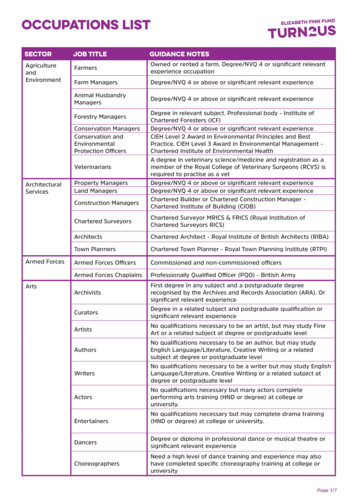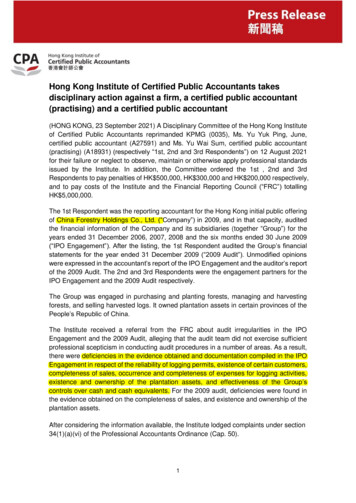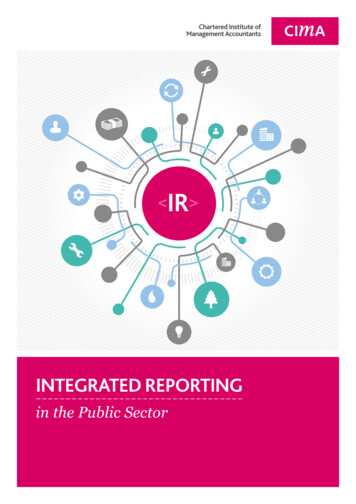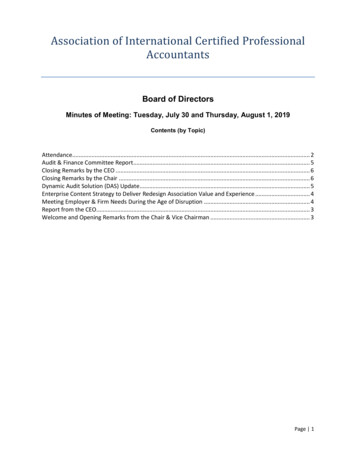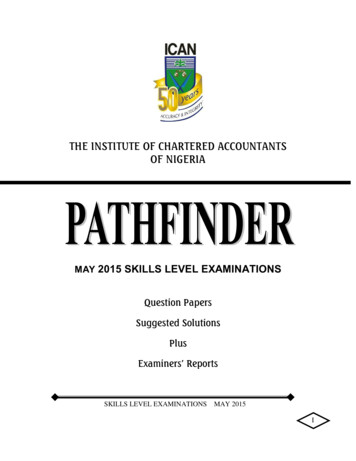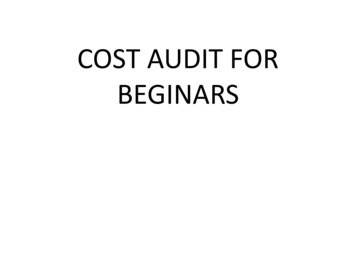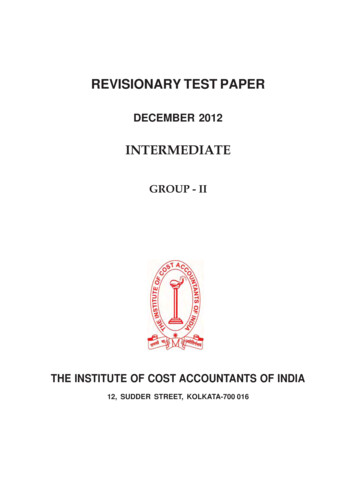
Transcription
REVISIONARY TEST PAPERDECEMBER 2012INTERMEDIATEGROUP - IITHE INSTITUTE OF COST ACCOUNTANTS OF INDIA12, SUDDER STREET, KOLKATA-700 016
Group-II : Paper-8 : Cost and Management Accounting[ December 2012 ] 1INTERMEDIATE EXAMINATION(REVISED SYLLABUS - 2008)GROUP - IIPaper-8 : COST AND MANAGEMENT ACCOUNTINGQ. 1. (a) Select the correct answer in each of the following :(i) The forex component of imported material cost is converted :(A) At rate on the date of settlement.(B) At rate on the date of transaction.(C) At rate on date of delivery.(D) Non of the above.(ii) Material cost variance is 550(A) and material price variance is 150(F), the material usagevariance should be :(A) 400(A)(B) 400(F)(C) 700(A)(D) 700(F)(iii) Maximum possible productive capacity of a plant when no operating time is lost , is its(A) Practical capacity(B) Theoretical capacity(C) Normal capacity(D) Capacity based on sales expectancy(iv) When production is below standard specification or quality and cannot be rectified by incurringadditional cost, it is called(A) Defective(B) Spoilage(C) Waste(D) Scrap(v) CAS 8 requires each type of utility to be treated as :(A) separate cost object(B) not part of cost as not include in material(C) not part of cost as they do not form part of product(D) treated as administrative overheads.
2 [ December 2012 ]Revisionary Test Paper (Revised Syllabus-2008)(vi) Selling and distribution overhead doesnot include:(A) Cost of warehousing(B) Repacking cost(C) Trasportation cost(D) Demurrage charges.(vii) Joint costs are allocated :(A) Based on a measure of the number of units, weight, or volume of joint products.(B) Based on the values attributed to the joint products.(C) Both of the above.(D) None of the above.(viii) When overtime is required for meeting urgent orders, overtime premium should be(A) Charged to Costing Profit and Loss A/c.(B) Charged to overhead costs.(C) Charged to respective jobs.(D) None of the above.(ix) Credit is given to the process account at a predetermined value of the byproduct under the—(A) Standard cost method(B) Reserve cost method(C) Opportunity cost method(D) Sales value(x) Exchange losses or gains after purchase transaction is complete is treated as :(A) Product cost.(B) Overhead cost.(C) Purchase cost.(D) Finance costQ. 1. (b) Fill in the blanks with appropriate word(s) :.(i) In Cost Accounting, abnormal losses are transferred to(ii) Reorder level .(iii) The technical term for charging of overheads to cost units is known as(iv) In brick kiln, cost unit is(v) Under(vi).system, there is no need of reconciliation of cost and financial accounts.determines the priorities in functional budgets.(vii) Gang composition variance is a sub variance ofvariance.(viii) When P/V ratio is 30% and M/S ratio is 40%, the profit is(ix) In contract costing , work in progress certified is valued atwork is valued at.% of sales.while uncertified(x) Cost sheet is a document which provides for assembly of the detailed cost of a.
Group-II : Paper-8 : Cost and Management Accounting[ December 2012 ] 3Q. 1. (c) Match each item in Column A with appropriate item in Column B :Column A(i)(ii)(iii)(iv)(v)(vi)(vii)(viii)(ix)(x)Cost reductionBreak even pointDifferential costingControl accountsCar manufactureEquivalent productionPeriod costDirector’s remunerationLiquidityFlux methodColumn B(A)(B)(C)(D)(E)(F)(G)(G)(I)(J)Cost book keepingMultiple costingNot assigned to productsValue analysisAdministration overheadWIPDecision makingCurrent ratioLabour turnoverNo profit no lossAnswer 1. (a)(i) (B) At rate on the date of transaction.(ii) (C) 700(A)Let M1 Actual cost of material used, M2 Standard cost of material used, M3 Standard cost ofmaterial in standard proportion, M4 Standard material cost of output.Material Price variance M1-M2 550(A)———(i)Material Cost variance M1- M4 150(F)————(ii)Subtracting (ii) from (i)Material usage variance M2-M4 700(A)(iii) (C) Normal capacityTheoretical capacity is the denominator-level concept that is based on producing at fullefficiency all the time., Practical capacity is a denominator-level concept that reduces thetheoretical capacity by unavoidable operating interruptions such as scheduled maintenancetime, shutdowns for holidays and so on. Normal capacity measures the denominator level interms of demand for the output of the plant. Normal capacity utilization is a concept based onthe level of capacity utilization that specifies the average customer demand over a time period,that includes seasonal, cyclical and trend factors.(iv) (B) Spoilage(1) Spoiled goods-goods that do not meet production standards and are either sold for theirsalvage value or discarded; (2) Defective units-goods that do not meet standards and are soldat a reduced price or reworked and sold at the regular or a reduced price; (3) Waste-materialthat is lost in the manufacturing process by shrinkage, evaporation, etc.; and (4) Scrap-byproduct of the manufacturing process that has a minor market value.(v) (A) separate cost object(vi) (D) Demurrage charges.(vii) (C) Both of the above.(viii) (C) Charged to respective jobs.When cost is incurred for specified job, the cost should be charged to that job only.
4 [ December 2012 ]Revisionary Test Paper (Revised Syllabus-2008)(ix) (A) Standard cost method(x) (D) Finance cost.Answer 1. (b)(i) Costing Profit and Loss A/c(ii) maximum consumption maximum reorder period(iii) absorption(iv) 1000 bricks(v) integral(vi) Key factor(vii) Labour efficiency(viii) 12(ix) contract price, cost(x) cost centre or cost unitAnswer 1. (c)(i) — (D)(ii) — (J)(iii) — (G)(iv) — (A)(v) — (B)(vi) — (F)(vii) — (C)(viii) — (E)(ix) — (H)(x) — (I)Q. 2. (a) The cost structure of an article the selling price of which is 45,000 is as follows :Direct Materials50%Direct Labour20%Overheads30%An increase of 15% in the case of materials and of 25% in the cost of labour is anticipated. Theseincreased costs in relation to the present selling price would cause a 25% decrease in the amountof profit per article.
[ December 2012 ] 5Group-II : Paper-8 : Cost and Management AccountingYour are required :(1) To prepare a statement of profit per article at present, and(2) The revised selling price to produce the same percentage of profit to sales as before.(b) Distinguish between :(i) ‘Cost centre’ and ‘cost unit’.(ii) Bill of material and material requisition note.Answer 2. (a)Working Notes :1. Let ‘x’ be the total cost and ‘y’ be the profit for an article whose selling price is 45,000Hence x y 45,000(A)2.Statement Showing Present and anticipated cost per articleItemPresent CostIncrease (1)Direct Material CostDirect ed cost (4)(5) (2) (4)0.075x0.050x—0.125x0.575x0.250x0.300x1.125x3. The increase in the cost of direct material and direct labour has reduced the profit by 25 per cent (asselling price remained unchanged). The increase is cost and reduction in profit can be represented bythe following relation :1.125x 0.75y 45,000(B)4. On solving relations (A) and (B) as obtained under working notes 1 and 3 above we get.We getx 30,000y 15,000(1)Present Statement of Profit Per ArticleDirect Material CostDirect Labour CostOverheadsTotal CostProfitSelling PriceNote : Profit as a percentage of Cost Price 50%( 15,000/ 30,000) 100Profit as a percentage of Selling Price 33-1/3%( 15,000/ 45,000) 100 0.5x0.2x0.3x15,0006,0009,00030,00015,00045,000
6 [ December 2012 ](2)Revisionary Test Paper (Revised Syllabus-2008)Statement of Revised Selling PriceDirect Material CostDirect Labour CostOverheadsTotal Anticipated CostProfit (33-1/3% of selling price)Selling Price( 33,750 100) 66.66 25Answer 2. (b) (i)Cost CentreCost UnitThe term Cost Centre is defined as a location,person or an item of equipment or a group of thesefor which costs may be ascertained and used forthe purposes of Cost Control. Cost Centres can bepersonal Cost Centres, impersonal Cost Centres,operation cost and process Cost Centres.Thus each sub-unit of an organisation is knownas a Cost Centre, if cost can be ascertained for it.In order to recover the cost incurred by a CostCentre, it is necessary to express it as the cost ofoutput.The term Cost Unit is defined as a unit of quantityof product, service or time (or a combination ofthese) in relation to which costs may beascertained or expressed. It can be for a job, batch,or product group.The unit of output in relation to which cost incurredby a Cost Centre is expressed is called a Cost Unit.Each sub-unit of an organisation is known as aCost Centre, if cost can be ascertained for it. Inorder to recover the cost incurred by a Cost Centre,it is necessary to express it as the cost of output.The unit of output in relation to which cost incurredby a Cost Centre is expressed is called a Cost Unit.(ii)Bill of materialIt is a comprehensive list of materials with exactdescription and specifications, required for a jobor other production units. This also providesinformation about required quantities so that ifthere is any deviation from the standards, it caneasily be detected. It is prepared by the Engineeringor Planning Department in a standard form.The purpose of bill of material is to act as a singleauthorisation for the issue of all materials andstores items mentioned in it. It provides anadvance intimation to store department about therequirements of materials. It reduces paper work.It serves as a work order to the productiondepartment and a document for computing thecost of material for a particular job or work orderto the cost department.Material requisition noteIt is a formal written demand or request, usuallyfrom the production department to store for thesupply of specified materials, stores etc. Itauthorises the storekeeper to issue therequisitioned materials and record the same onbin card.The purpose of material requisition note is to drawmaterial from the store by concerned departments.
[ December 2012 ] 7Group-II : Paper-8 : Cost and Management AccountingQ. 3. (a) (i) ABC Ltd has received an offer of quantity discounts on his order of materials as under :Price per tonne 1,2001,1801,1601,1401,120TonnesNos.Less than 500500 and less than 1,0001,000 and less than 2,0002,000 and less than 3,0003,000 and above.The annual requirement for the material is 5,000 tonnes. The ordering cost per order is 1,200and the stock holding cost is estimated at 20% of material cost per annum. You are required tocomplete the most economical purchase level.(ii) What will be your answer to the above question if there are no discount offered and the priceper tonne is 1,500?(b) What is material handling cost? How will you deal it in Cost Accounts?Answer 3. (a)(i)TotalAnnualRequirementOrdersize(units)No. ofOrdersCost ofInventory S Per unit costOrderingCost(A)q(A) 1 q 20% of2cost per unit 8,000(200 240)59,000(250 236)1,16,000(500 232)2,28,000(1,000 228)3,36,000(1500 224)60,63,00050060,00,000(5,000 1200)59,00,000(5,000 1180)58,00,000(5,000 1160)57,00,000(5,000 1140)56,00,000(5,000 1120)(A) 120015,00012,0006,0003,0002,000Carrying Costp.u. p. a.TotalCost(4 5 6) 59,71,00059,22,00059,31,00059,38,000The above table shows that the total cost of 5000 units including ordering and carrying cost is minimum( 59,22,000) when the order size is 1000 units. Hence the most economical purchase level is 1000 units.
8 [ December 2012 ]Revisionary Test Paper (Revised Syllabus-2008)2 A OWhere A is the annual inventory requirement, O, is the ordering cost per order andCC is the carrying cost per unit per annum.(ii) EOQ 2 5000 120020% 1500 200 tonnesAnswer 3. (b)Material handling cost refers to the expenses involved in receiving, storing, issuing and handling materials.To deal with this cost in cost accounts there are two prevalent approaches as under :First approach suggests the inclusion of these costs as part of the cost of materials by establishing aseparate material handling rate e.g., at the rate of percentage of the cost of material issued or by using aseparate material handling rate which may be established on the basis of weight of materials issued.Under another approach these costs may be included along with those of manufacturing overhead and becharged over the products on the basis of direct labour or machine hours.Q. 4. (a) The following data are available in respect of material X for the year ended 31st March 2012. Opening stock90,000Purchase during the year2,70,000Closing stock1,10,000Calculate —(i) Inventory turnover ratio; and(ii) the number of days for which the average inventory is held.(b) At what price per unit would Part No. G 112 be entered in the Stores Ledger, if the followinginvoice was received from a supplier :Invoice 200 units Part No. G112 @ 51,000.00Less: 20% discount200.00800.00Add: Excise Duty @ 10%80.00880.00Add Packing charges (5 non-returnable boxes)50.00930.00Notes:(i) A 2% discount will be given for payment in 30 days.(ii) Documents substantiating payment of excise duty is enclosed for claiming MODVAT credit.(c) From the details given below, calculate(i) Re-ordering level(ii) Maximum level(iii) Minimum level
[ December 2012 ] 9Group-II : Paper-8 : Cost and Management Accounting(iv) Danger levelRe-ordering quantity is to be calculated on the basis of following information :Cost of placing a purchase order is 20Number of units to be purchased during the year is 5,000.Purchase price per unit inclusive of transportation cost is 50.Annual cost of storage per unit is 5.Details of lead time : Average 10 days, Maximum 15 days, Minimum6 days. For emergency purchases 4 days.Rate of consumption : Average: 15 units per day, Maximum : 20 units per day.Answer 4. (a)(i) Inventory turnover ratio Cost of stock of raw material consumedAverage stock of raw material 2,50,000 1,00,000(Refer to working note) 2.5(ii) Average number of days for which theaverage inventory is held365 days365 days Inventory turnover ratio 2.5 146 daysWorking note : 90,0002,70,0001,00,0002,50,000Opening stock of raw material on 1.4.2011 Add: Material purchases during the year Less: Closing stock of raw material Cost of stock of raw material consumedAverage stock of raw material 1 Opening stock of Closing stock of raw material 2 raw material 1{ 90,000 1,10,000} 1,00,0002Answer 4. (b)200 units net cost after trade discountAdd: Packing chargesTotal cost for 200 unitsCost per unit 850 4.2520080050850
10 [ December 2012 ]Revisionary Test Paper (Revised Syllabus-2008)Answer 4. (c)Basic data :O (Ordering Cost per order)A (Number of units to be purchased annually)P (Purchase price per unit inclusive of transportation cost)C (Annual cost of storage per unit) 205,000 units 50 5Workings :(i) Re-ordering level(ROL)(ii) Maximum level Maximum usage Maximum re-orderper periodperiod 20 units per day 15 days 300 units Minimum rate Minimum reorder ROL ROQ – of consumption period (Refer to working note 1 and 2) 10 units Average reorder 300 units 200 units – per day period 440 units(iii) Minimum level Average rate Average reorder ROL – of consumption period 300 units – (15 units per day 10 days) 150 units(iv) Danger level Average consumption Lead time for emergency purchases 15 units per day 4 days 60 unitsWorking Notes :1. ROQ 2AO C2 5,000 units 20 5 200 units2. Average rate of consumption Minimum rate of consumption (x) Maximum rate of consumption2x 20 units per day215 units per day or x 10 units per day
Group-II : Paper-8 : Cost and Management Accounting[ December 2012 ] 11Q. 5. (a) Discuss the accounting treatment of Idle time and overtime wages.(b) The cost accountant of Zed Ltd. has computed labour turnover rates for the quarter ended 31stMarch, 2012 as 10%, 5% and 3% respectively under Flux method, ‘Replacement method’ and‘Separation method’. If the number of workers replaced during that quarter is 30, find out thenumber of (i) workers recruited and joined and (ii) workers left and discharged.Answer 5. (a)Accounting treatment of idle time wages in cost accounts :Normal idle time is treated as a part of the cost of production. Thus, in the case of direct workers, anallowance for normal idle time is built into the labour cost rates. In the case of indirect workers, normalidle time is spread over all the products or jobs through the process of absorption of factory overheads.Abnormal idle time: It is defined as the idle time which arises on account of abnormal causes; e.g. strikes;lockouts; floods; major breakdown of machinery; fire etc. Such an idle time is uncontrollable.The cost of abnormal idle time due to any reason should be charged to Costing Profit & Loss Account.Accounting treatment of overtime premium in cost accounts :If overtime is resorted to at the desire of the customer, then the overtime premium may be charged to thejob directly. If overtime is required to cope with general production programme or for meeting urgent orders, theovertime premium should be treated as overhead cost of particular department or cost center whichworks overtime. Overtime worked on account of abnormal conditions should be charged to costing Profit & LossAccount. If overtime is worked in a department due to the fault of another department the overtime premiumshould be charged to the latter department.Answer 5. (b)Working Note :Average number of workers on roll:No. of replacementsLabour turnover rate (under Replacement method) Average number of wor ker s on roll 100305 10 Average number of workers on rollOrAverage number of workers on roll 30 100 6005 No. of separations (S) No. of accessions (A) 100Av. number of workers on roll 18 A600(i) Number of workers recruited and joined :Labour turnover rate (Flux method)(Refer to Working Note)Or10100Or A 6000 100 – 18 42
12 [ December 2012 ]Revisionary Test Paper (Revised Syllabus-2008)No. of workers recruited and joined 42.(ii) Number of workers left and discharged :No. of separation s (S)Labour turnover rate (Separation method) Av. number of wor ker s on roll 100(Refer to working note)3S 100 600Or S 18Hence, number of workers left and discharged comes to 18.Q. 6. (a) A job can be executed either through workman A or B. A takes 32 hours to complete the jobwhile B finishes it in 30 hours. The standard time to finish the job is 40 hours.The hourly wage rate is same for both the workers. In addition workman A is entitled to receivebonus according to Halsey plan (50%) sharing while B is paid bonus as per Rowan plan. The worksoverheads are absorbed on the job at 7.50 per labour hour worked. The factory cost of the jobcomes to 2,600 irrespective of the workman engaged.Find out the hourly wage rate and cost of raw materials input. Also show cost against eachelement of cost included in factory cost.(b) The management of SS Ltd. wants to have an idea of the profit lost/foregone as a result of labourturnover last year.Last year sales accounted to 66,000,000 and the P/V Ratio was 20%. The total number of actualhours worked by the direct labour force was 3.45 lakhs. As a result of the delays by the PersonnelDepartment in filling vacancies due to labour turnover, 75,000 potential productive hours werelost. The actual direct labour hours included 30,000 hours attributable to training new recruits,out of which half of the hours were unproductive. The costs incurred consequent on labourturnover revealed on analysis the following : Settlement cost due to leaving27,420Recruitment costs18,725Selection costs12,750Training costs16,105Assuming that the potential production lost due to labour turnover could have been sold atprevailing prices, ascertain the profit foregone/lost last year on account of labour turnover.Answer 6. (a)Working notes :1. Time saved and wages :WorkmenStandard time (hrs.)Actual time taken (hrs.)Time saved (hrs.)Wages paid @ x per hr. ( )A40320832xB40301030x
Group-II : Paper-8 : Cost and Management Accounting[ December 2012 ] 132. Bonus Plan :Time saved (hrs.)Bonus ( )Halsey84x 8 hrs x 2Rowan107.5x 10 hrs 40 hrs 30hrs 3. Total wages :Workman A: 32x 4x 36xWorkman B: 30x 7,5x 37.5xStatement of factory cost of the jobWorkmenAB Material costyyWages36x37.5x(Refer to working note 3)Works overhead240225Factory cost2,6002,600The above relations can be written as follows :36x y 240 2,600 . (i)37.5x y 225 2,600 . (ii)Answer 6. (b)Working notes :1. Actual productive hours(Actual hours worked – Unproductive training hours)(3,45,000 hrs. – 15,000 hrs.)2. Sales per productive hour ( )(Total Sales/Actual productive hours)( 66,00,000/3,30,000 hrs.)3. Potential productive hours lost4. Sales foregone ( )(75,000 hours 20)5. Contribution foregone ( )P/V ratio Sales foregone)(20% 15,00,000)3,30,0002075,00015,00,0003,00,000 x
14 [ December 2012 ]Revisionary Test Paper (Revised Syllabus-2008)Statement of Profit foregoneas a result of labour turnover of M/s. SS Ltd. 3,00,000Contribution foregone(Refer to working note 5)Settlement cost due to leavingRecruitment costsSelection costsTraining costsTotal profit g (i) from (ii) we get1.5x – 15 0or 1.5 x 15orx 10 per hourOn substituting the value of x in (i) we get y 2,000Hence the wage rate per hour is 10 and the cost of raw material input is 2,000 on the job.Q. 7. (a) A departmental store has several departments. What bases would you recommend forapportioning the following items of expense to its departments :(i) Fire insurance of Building.(ii) Rent(iii) Delivery Expenses.(iv) Purchase Department Expenses.(v) Credit Department Expenses.(vi) General Administration Expenses.(vii) Advertisement.(viii) Sales Assistants Salaries.(ix) Personal Department expenses.(x) Sales Commission(b) PQ Ltd. is a manufacturing company having three production departments, ‘A’ ‘B’ and ‘C’ and twoservice departments ‘S1’ and ‘S2’. The following is the budget for December 2011 :Total Direct MaterialDirect WagesFactory rentPowerDepreciationOther overheadsAdditional informationArea (Sq. ft.)Capital Value ( Lacs) of assetsMachine hoursHorse power of machinesA 1,0005,000B 2,0002,000C 4,0008,000S1 2,0001,000S2 01,00015500101,000254,0002,5001,0009,000
[ December 2012 ] 15Group-II : Paper-8 : Cost and Management AccountingA technical assessment or the apportionment of expenses of service departments is as under :ABCS1S2%%%%.%Service Dept. ‘S1’45153010Service Dept. ‘S2’60355Required :(i) A statement showing distribution of overheads to various departments.(ii) A statement showing re-distribution of service departments expenses to productiondepartments.(iii) Machine hours rates of the production departments ‘A’, ‘B’ and ‘C’.Answer 7. (a)Items of expensesFire Insurance of Building.RentDelivery Expenses.Purchase department ExpensesCredit Department Expenses.General Administration Expenses.Advertisement.Sales Assistants Salaries.Personal Department expenses.Sales CommissionAnswer 7. (b)(i)Overhead Distribution SummaryBasisDirect materialsDirect wagesFactory rentPowerDepreciationOtherOverheadsBasis For apportioningFloor AreaFloor AreaVolume or Distance or WeightNo. of Purchase order/Value of PurchasesCredit Sales ValueWorks costActual salesActual/Time devotedNo. of EmployeesActualDirect,,AreaH.P X M/c Hrs.Cap. ValueM/c hrs.Total A B C S1 006,0001,0004,750S2 1,0002,0001,0002501001,0005,350
16 [ December 2012 ](ii)Revisionary Test Paper (Revised Syllabus-2008)Redistribution of Service Department’s expenses:Total OverheadsDept . X overhead apportioned in the ratio(45 : 15 : 30 : 10)Dept . Y overhead apportioned in the ratio(60: 35 : — : 5)Dept . X overhead apportioned in the ratio(45 : 15 : 30 : 10)Dept . Y overhead apportioned in the ratio(60: 35 : — : 5)Dept . X overhead apportioned in the ratio(45 : 15 : 30 : 10)(iii) Machine Hour rateMachine hoursMachine hour rate ( )A 2,7002,138B 3,700712C 6,0001,425S1 4,750- 4,750S2 5,3504753,4952,039—291- 5,8251314487- 291291710—2- 54,0001.88Q. 8. (a) In FBG Ltd, factory overhead was recovered at a pre- determined rate of 25 per man – day. Thetotal factory overhead expenses incurred and the man-days actually worked were 41.50 lacsand 1.5 lacs man-days respectively. Out of the 40,000 units produced during a period, 30,000were sold.On analysing the reasons, it was found that 60% of the unabsorbed overheads were due todefective planning and the rest were attributable to increase in overhead costs.How would unabsorbed overheads be treated in Cost Accounts?(b) KBC Ltd manufacturing two products furnishes the following data for a year.ProductABAnnual output(Units)5,00060,000Total Machinehours20,0001,20,000Total number ofpurchase orders160384Total number ofset-ups2044The annual overheads are as under :Volume related activity costsSet up related costsPurchase related costs 5,50,0008,20,0006,18,000You are required to calculate the cost per unit of each Product A and B based on :(i) Traditional method of charging overheads.(ii) Activity based costing method.
Group-II : Paper-8 : Cost and Management Accounting[ December 2012 ] 17Answer 8. (a)Computation of Unabsorbed OverheadsMan – days worked1,50,000 Overhead actually incurredLess : Overhead absorbed @ 25%/- per man - day( 25 1,50,000)Unabsorbed OverheadsUnabsorbed Overheads due to defective planning(i.e 60% of 4,00,000)Balance of Unabsorbed 0Treatment of Unabsorbed Overheads in Cost Accounts(i) The unabsorbed overheads of 2,40,000 due to defective planning to be treated as abnormal andtherefore be charged to Costing Profit and Loss Accounts.(ii) The balance unabsorbed overheads of 1,60,000 be charged to production i.e. 40,000 units at thesupplementary overhead absorption rate i.e. 4/- per unit.(Refer to Working Note) Charge to Costing Profit and Loss Account as part of thecost of units sold (30,000 units @ 4/-p.u.)Add : To Closing stock of finished goods(10,000 units @ 4/- p.u.)TotalWorking Note :Supplementary Overhead Absorption Rate 1,60,000 40,000 4/- p.u.Answer 8. (b)Working notes :1. Machine hour rate2. Machine hour rate Total annual overheadsTotal machine hours 19,88,0001,40,000 hours 14.20 per hour Total annual overhead cost for volume related activitiesTotal machine hours 5,50,0001,40,000 hours 3.93 (approx.)1,20,00040,0001,60,000
18 [ December 2012 ]Revisionary Test Paper (Revised Syllabus-2008)3. Cost of one set-up4. Cost of a purchase order(i) Total cos ts related to set upsTotal number of set ups 8,20,00064 set ups 12,812.50 Total costs related to purchasesTotal number of purchase order 6,18,000544 orders 1,136.03Statement showing overhead cost per unit(based on traditional method of charging oursA5,00020,000B60,0001,20,000(ii)Overhead cost component(Refer to W, Note 1) Overhead costper unit 2,84,000(20,000 hrs. 14.20)17,04,000(1,20,000 hrs. 14.20)56.80( 2,84,000 / 5,000 units)28.40( 17,04,000/60,000 units)Statement showing overhead cost per unit(based on activity based costing a)(b)A5,00020,000B60,0001,20,000Costrelated tovolumeactivities (c)78,600(20,000 hrs 3.93)4,71,600(1,20,000 hrs 3.93)Costrelated topurchasesCostrelated toset-upsTotal costCost perunit (d) (e) (f) [(c) (d) (e)] (g) 80(160 orders 1136.03)4,36,235.52(384 orders 1136.03)2,56,250(20 set ups 12,812.50)5,63,750(44 set ups 12,812.50)Note : Refer to working notes 2,3 and 4 for computing costs related to volume activities, set-ups andpurchases respectively.
Group-II : Paper-8 : Cost and Management Accounting[ December 2012 ] 19Q. 9. (a) What do you understand by Batch Costing? In which industries it is applied?(b) Discuss the process of estimating profit/loss on incomplete contracts.(c) P and E are engaged in construction and erection of a bridge under a long-term contract. The costincurred upto 31.03.2012 was as under : in lacsFabricationDirect Material280Direct Labour100Overheads60440Erection costs to date110550The contract price is 11 crores and the cash received on account till 31.03.2012 was 6 crores.The technical estimate of the contract indicates the following degree of completion of work.Fabrication – Direct Material – 70%, Direct Labour and Overheads 60% Erection – 40%.You are required to estimate the profit that could be taken to Profit and Loss Account against thispartly completed contract as at 31.03.2012.Answer 9. (a)Batch Costing is a form of job costing. In this, the cost of a group of products is ascertained. The unit ofcost is a batch or a group of identical products instead of a single job, order or contract. Separate costsheets are maintained for each batch of products by assigning a batch number. The cost per unit isascertained by dividing the total cost of a batch by the number of items produced in that batch.Batch costing is employed by companies manufacturing in batches. It is used by readymade garmentfactories for ascertaining the cost of each batch of cloths made by them. Pharmaceutical or drug industries,electronic component manufacturing units, radio manufacturing units too use this method of costing forascertaining the cost of their product.Answer 9. (b)Process of estimating profit / loss on incomplete contracts(i) If completion of contract is less than 25% no profit shoul
Group-II : Paper-8 : Cost and Management Accounting [December 2012] 7 Q. 3. (a) (i) ABC Ltd has received an offer of quantity discounts on his order of materials as under : Price per tonne Tonnes Nos. 1,200 Less than 500 1,180 500 and less than 1,000 1,160 1,000 and less than 2,000 1,140 2,000 and less than 3,000 1,120 3,000 and above.


